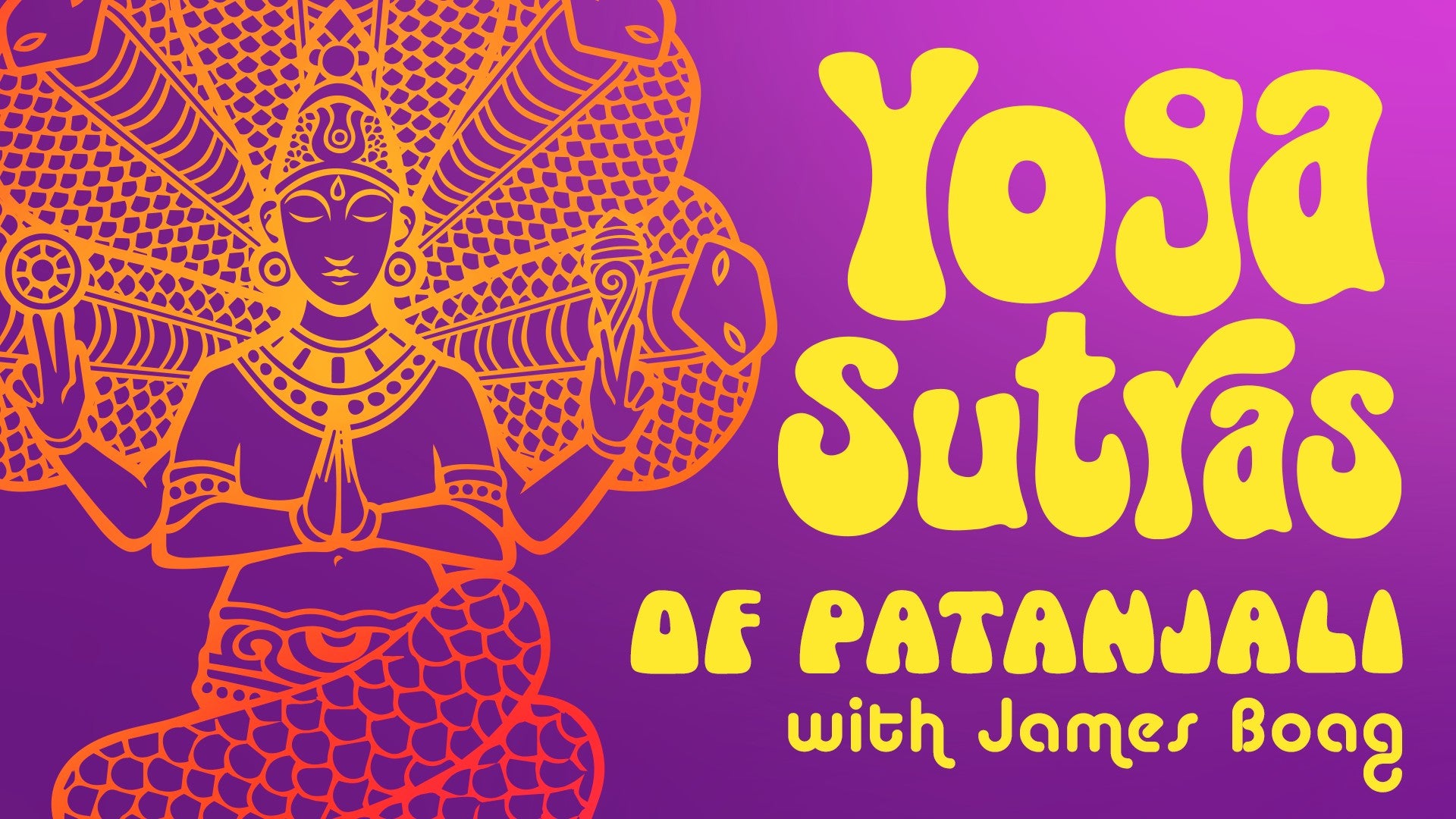Description
About This Video
Transcript
Read Full Transcript
Sutra 51. So continuing his description of pranayama, potentially, he introduces his idea of Chaturthaha, the force Baja Bantara. So, Baja, Anantara, this is the external and the internal. Visayak shipping. Beyond that is the 4th. So in the previous couple of sutures, we had the idea as we carefully steadily, patiently monitor the movements of the breath, according to place time and number, we can invite that experience of pranayam, becoming deeper and subtler.
And potentially says as this practice becomes deeper and subtler and subtler still, then it can penetrate through to the 4th state, the 4th state? What is this? So in yoga, we can hear of 4 states of awareness, waking, dreaming, sleeping, and Chaturtha, the 4th state, also known as Puria. And this is the idea that through Pranayam, through attuning ourselves to the subtler movements retentions, pauses, cycles of the breath and the life force in and through our bodily vehicle. That can be a conveyance, if you like, or a means to help our awareness drop into this subtler clear estate. And 1 thing about this that's, I think, worth mentioning is that it kinda highlights the distinction between certain, let's say, gross or more external practices and those subtler internal practices. Sometimes, for example, let's say somebody started to meditate with a classic seated meditation practice, morning, and evening, half an hour each time, let's say.
And their friend notices, wow, you you know, you're you seem to be really vibrant these days. You're looking really well. And he's like, yeah, I've started to meditate. Oh, 0, and then then the frame might say, oh, 0, running is my meditation. Zumba class is my meditation or gardening is my meditation or whatever it might be. And, certainly, any type of activity can become a meditative practice.
And yet, there is also in the old tradition, it is highlighted. There is a difference between those relatively gross practices, which could be in the realm of pranayama. So there are some types of pranayama. They're very we're still relatively externally focused. We're noticing the physical body moving.
We're taking vigorous breaths, for example. Or we could be doing arsenal moving in space dynamically. This is relatively external. And yet, they could have a very meditative quality, just like if we were cooking the meal with great presents or doing some woodwork or whatever it might be, This could bring us into a very meditative state. But what's the difference between this subtle internal practice and running, or carpentry or gardening, whatever it might be.
There's the idea that when our India, when our sense and action powers, are deployed externally. Even if, say, for example, we're standing on our head, we're doing yoga. Some of our awareness is recruited, is demanded to stop a toppling over, or if we're working in the garden to make sure that, you know, if we're using a tool, we're gonna use it, not gonna hurt ourselves. We can become very absorbed in the activity, and it can be a certain depth of Samadhi experience. But there's still a limit to how deep that can take us because we have to still operate in the external phenomenological world.
They said that when we work with the life force and the breath, this can journey inwards as it were. And this can take us into that very, very subtle realm, which is only really accessible when we give permission to the sense and action powers to turn in. And Tanya's gonna speak more about that in a little while. That's not to say that all those more gross external practices are not of tremendous value. 1 of my Indian teachers 1 time said, you know, arsenic, I have to remember it's kindergarten practice.
Not in the sense that we leave it behind once we get to 5 or 6 years old, But rather that if you go to a good kindergarten, there we will learn principles that will be of tremendous support for the rest of our dedicated, our complex, our subtle practice, who may graduate, too. But if we go to a good kindergarten, we will learn principles which can support us a whole life long. So if we work with yoga, we like doing yoga posture practices, or we like doing relatively gross pranayama practices, there's the idea. These can be tremendously powerful practices because they can instill at a cell deep level a real initial understanding of those principles and how we can enact them, how we can bring them into all aspects of our lives. So if we read this and think, oh, I well, I'm I'm not sure.
I'm doing my pruning my practice, and I'm enjoying the breath, becoming and I do feel my body's able to breathe much more easily through the rest of the day. And when I do, for example, my prony arm, my arse, and perhaps in the morning, if I have to sprint for the bus in the afternoon. I know, so I don't get out of my breath. My lungs are nicely repaired. And yet, I don't know if I'm accessing this false state. No worry.
But this can happen that the awareness can access this place where it's no longer in and out. It's just in this place of deep subtle presence. It's not wakefulness. It's not sleep. It's not dream. It's a place of crisp, clear, lucid awareness, but in a realm that's much subtler, than I would access in my waking state in a realm that's much realer than I would access in my dream state.
In a realm that's much more present, don't access in the sleep state. And so at the areas with meditative practices, with pranayama, It's this portal that can help us travel that pathway from gross to subtle. And if we do use as a mental support, the movements of the life force and the prana Potanage, it was remember in the chapter 1, this was the first thing Botanagely mentioned we could use as a support, which is so beautiful because we so if we're alive as a human being, We always have it available. We are all initiated into it as soon as we emerge from the womb. We breathe in.
And then we breathe out possibly with sound. So we can work with the breath. We can work with the life force. And it's such an amazing rlambana support or substrate for yogic meditative practice because it lends itself to this journey from gross to subtle. If we just stop pause, close our eyes, and invite ourselves to experience the breath.
Without asking it to do anything in particular, just allowing myself to experience the breath. What happens if we're able to be with that practice for a little while, and it's not particularly easy practice because there is often a temptation to try to influence or shift the breath. But if we can just observe it, we'll often notice is the breath does start to become subtler, softer, quieter, a little bit easier. And if we keep working with that, then, but only gives us the invitation. As we keep tracking, tracing, and monitoring the movements of the life force, this can be a means to access that deeper subtler state and open the gateway to even deeper subtler stages of meditative experience.
Prakasha, excuse me, Prakasha Varanam, and then what happens? Is dissolved, is destroyed, the the covering of the precaution. Of the self evolving light of consciousness. It's the idea. As we keep inviting our awareness, to become softer and softer and subtler, then we will remove the covering to that self evolgent light of our deeper consciousness.
What striking here, we don't need to do anything to the light. All we're doing is removing the covering. How do we remove the covering by inviting our awareness to become subtler, to become more centered, to become more concentrated, more balanced, more yogic. Made the seat of our awareness, become more serious for James. May become more centered.
And when that happens and we continue in that vein, then we can begin to remove those veils. Remember back at the beginning of the chapter, what is this Sardhanah, this path of yoga practice for, to promote or invite or strengthen Samadhi and to attenuate and diminish the glaciers. Same idea here. As we keep tracing the movements of the life force back to their subtle source, we will remove those barriers to actually experiencing the source.







You need to be a subscriber to post a comment.
Please Log In or Create an Account to start your free trial.